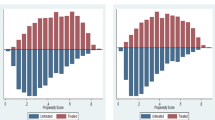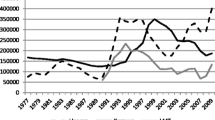Abstract
We use a long panel data set for four cohorts of male blue-collar workers entering into an internal labor market to analyze the effect of age on the probability of participating in different employer-financed training measures. We find that training participation probabilities are inverted u-shaped with age and that longer training measures are undertaken earlier in life and working career. These findings are consistent with predictions from a human capital model that incorporates amortization period and screening effects.
Similar content being viewed by others
References
Acemoglu, D. & Pischke, J.-S. (1998). Why do firms train? Theory and evidence. Quarterly Journal of Economics, 113, 79–119
Alvarez, M. R. & Nagler, J. (1995). Economics, issues and the Perot candidacy: voter choice in the 1992 presidential election. American Journal of Political Sciences, 39(3), 714–744
Arulampalam, W. & Booth, A. L. (1997). Who gets over the training hurdle? A study of the training experiences of young men and women in Britain. Journal of Population Economics, 10(2), 197–217
Arulampalam, W.; Bryan, M. L. & Booth, A. L. (2004). Training in Europe. Journal of the European Economic Association, 2(2–3), 346–360
Becker, G. S. (1962). Investments in human capital: a theoretical analysis. Journal of Political Economy, 7(5), 9–49
Becker, G. S. (1993). Human capital: a theoretical and empirical analysis with special reference to education. 3rd ed. Chicago: The University of Chicago Press
Booth, A. L. & Bryan, M. L. (2002). Who pays for general training? New evidence for British men and women. IZA Discussion Paper, 486. Bonn: IZA
Chan, S. & Stevens, A. H. (2001). Job loss and employment patterns of older workers. Journal of Labor Economics, 19(2), 484–521
Cleveland, W. S. (1979). Robust locally weighted regression and smoothing scatterplots. Journal of the American Statistical Association, 74(368), 829–836
Dow, J. K. & Endersby, J. W. (2004). Multinomial probit and multinomial logit: a comparison of models for voting research. Electoral Studies, 23(1), 107–122
EU [European Union] (2009). Employment in Europe. Brussels: European Union
Farber, H. S. & Gibbons, R. (1996). Learning and wage dynamics. Quarterly Journal of Economics, 111, 1007–1047
Frazis, H.; Gittleman, M. & Joyce, M. (2000). Correlates of training: an analysis using both employer and employee characteristics. Industrial and Labor Relations Review, 53(3), 443–462
Friedberg, L. (2003). The impact of technological change on older workers: evidence from data on computer use. Industrial and Labor Relations Review, 56(3), 511–529
Gruber, J. & Wise, D. (1998). Social security and retirement: an international comparison. American Economic Review, 88(2), 158–163
Hausman, J. & McFadden, D. (1984). Specification tests for the multinomial logit model. Econometrica, 52(5), 1219–1240
Hutchens, R. M. (1988). Do job opportunities decline with age? Industrial and Labor Relations Review, 42(1), 89–99
Jovanovic, B. (1979). Job matching and the theory of turnover. Journal of Political Economy, 87, 972–990
Kropko, J. (2008). Choosing between multinomial logit and multinomial probit models for analysis of unordered choice data. Chapel Hill: University of North Carolina [Dissertation]
Lange, F. (2007). The speed of employer learning. Journal of Labor Economics, 25, 1–35
Lazear, E. P. (1979). Why is there mandatory retirement? Journal of Political Economy, 87(6), 1261–1284
Leuven, E. & Oosterbeek, H. (1999). The demand and supply of work-related training: evidence from four countries. Research in Labor Economics, 18, 303–330
Maximiano, S. & Oosterbeek, H. (2007). On the determinants of workers’ and firms’ willingness to train. Conference paper, European Association of Labour Economists (EALE), Oslo, 2007
O’Connell, P. J. & Byrne, D. (2009). The determinants and effects of training at work: bringing the workplace back in. ESRI Working Paper, 289. Dublin: ESRI
OECD (2005). Ageing and employment policies. Paris: OECD
OECD (2008). Employment Outlook. Paris: OECD
Oosterbeek, H. (1998). Unravelling supply and demand factors in work-related training. Oxford Economic Papers, 50, 266–283
Riphahn, R. T. & Trübswetter, P. (2006). Population aging and continued education. IZA Discussion Paper, 2415. Bonn: IZA
Sousa-Poza, A. & Henneberger, F. (2003). The determinants and wage effects of course-related training of elderly workers in Switzerland. Research Institute for Labour Economics and Labour Law Discussion Paper, 94. St. Gallen: University of St. Gallen
Topel, R. H. & Ward, M. P. (1992). Job mobility and the careers of young men. Quarterly Journal of Economics, 107, 439–479
Veum, J. R. (1996). Training and job mobility among young workers in the United States. Journal of Population Economics, 10, 219–233
Author information
Authors and Affiliations
Corresponding author
Additional information
This work was financially supported by the VolkswagenStiftung. We thank Jens Mohrenweiser, Patrick Puhani, participants of the Colloquium in Personnel Economics 2010 in Trier, and two referees of this journal for their comments.
Rights and permissions
About this article
Cite this article
Pfeifer, C., Janssen, S., Yang, P. et al. Training participation of a firm’s aging workforce. Empirical Res Voc Ed Train 4, 131–147 (2012). https://doi.org/10.1007/BF03546513
Published:
Issue Date:
DOI: https://doi.org/10.1007/BF03546513




